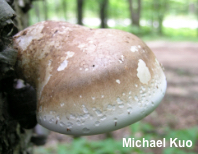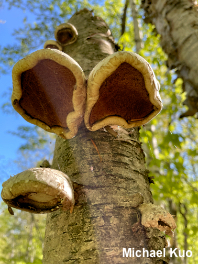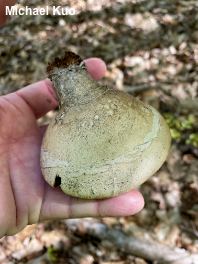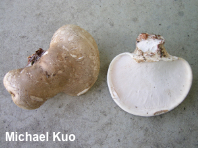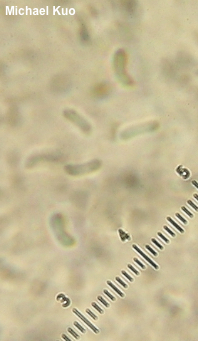| Major Groups > Polypores > Fomitopsis betulina |

|
[ Basidiomycota > Polyporales > Fomitopsidaceae > Fomitopsis . . . ] Fomitopsis betulina by Michael Kuo, 26 September 2022 Anyone who has spent time in birch woods has seen Fomitopsis betulina on dead birch trees and logs, or occasionally on still-living trees. The species is an attractive polypore, easily recognized by its habitat on birch wood and the fact that the cap folds over to make a distinctive, smooth rim around the pore surface. The caps are whitish to brownish, and the pore surface is whitish or grayish brown. Although Fomitopsis betulina is annual and does not actually live for more than one season, its fruiting bodies are somewhat tough and are often found in the next year (usually somewhat blackened). Piptoporus betulinus is a well-known previous name. Description: Ecology: Saprobic on the deadwood of birch trees, including European white birch, paper birch, and yellow birch; also sometimes reported as parasitic on living trees; causing a brown cubical rot; growing alone or gregariously; annual; originally described from France; widespread and common in Europe, western Asia, and North America, wherever the host trees occur; also occasionally reported from South America. The illustrated and described collections are from Michigan. Cap: At first lump-like and nearly spherical; at maturity 5–25 cm across and 4–10 cm deep; more or less semicircular in outline; convex or broadly convex; smooth or slightly roughened; whitish at first, becoming brownish and, eventually, dull brown; with a thick margin that is rolled over smoothly to form a rim around the pore surface. Pore Surface: White, aging grayish to brownish; not bruising; with 2–4 pores per mm; tubes to 1 cm long. Stem: Absent or rudimentary and stubby. Flesh: White; unchanging when sliced; thick; corky. Odor and Taste: Odor strong and fragrant when fresh; taste usually a little bitter. Microscopic Features: Spores 4–6 x 1–1.5 µm; allantoid; smooth; hyaline in KOH; inamyloid. Cystidia not found. Setae not found. Hyphal system dimitic; skeletal hyphae 3–6 µm wide, smooth, thick-walled, aseptate, hyaline to slightly yellowish in KOH; generative hyphae 2–3 wide, smooth, thin-walled, hyaline in KOH, clamped. REFERENCES: (Bulliard, 1780) B. K. Cui, M. L. Han & Y. C. Dai, 2016. (Overholts, 1953; Phillips, 1981; Arora, 1986; Breitenbach & Kränzlin, 1986; Gilbertson & Ryvarden, 1987; Phillips, 1991/2005; Schalkwijk-Barendsen, 1991; Lincoff, 1992; Barron, 1999; Roody, 2003; McNeil, 2006; Miller & Miller, 2006; Crockatt, 2008; Kuo & Methven, 2010; Buczacki et al., 2013; Ortiz-Santana et al., 2013; Kuo & Methven, 2014; Han et al., 2016; Baroni, 2017; Ginns, 2017; Gminder & Böhning, 2017; Justo et al., 2017; Kibby, 2017; Woehrel & Light, 2017; Elliott & Stephenson, 2018; Læssøe & Petersen, 2019; McKnight et al., 2021.) Herb. Kuo 09080102, 09150719, 09111001, 05251402. This site contains no information about the edibility or toxicity of mushrooms. |
© MushroomExpert.Com |
|
Cite this page as: Kuo, M. (2022, September). Fomitopsis betulina. Retrieved from the MushroomExpert.Com Web site: http://www.mushroomexpert.com/fomitopsis_betulina.html |
